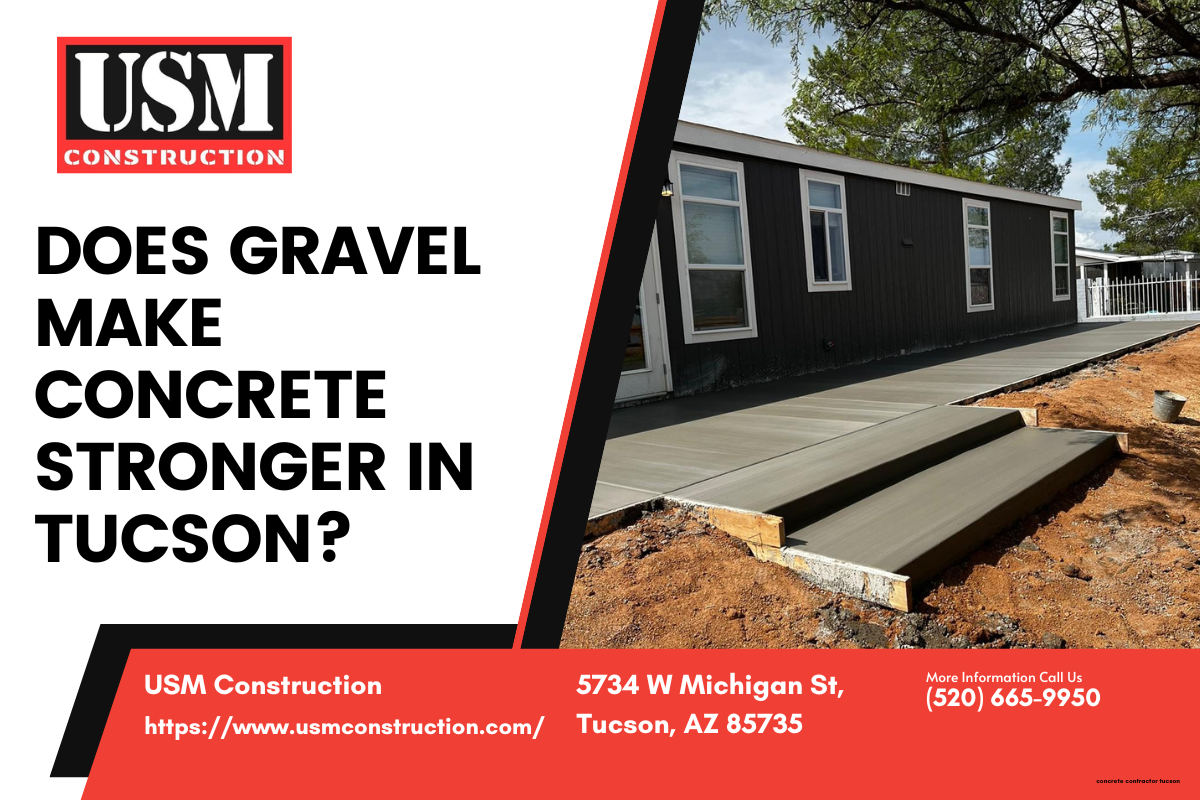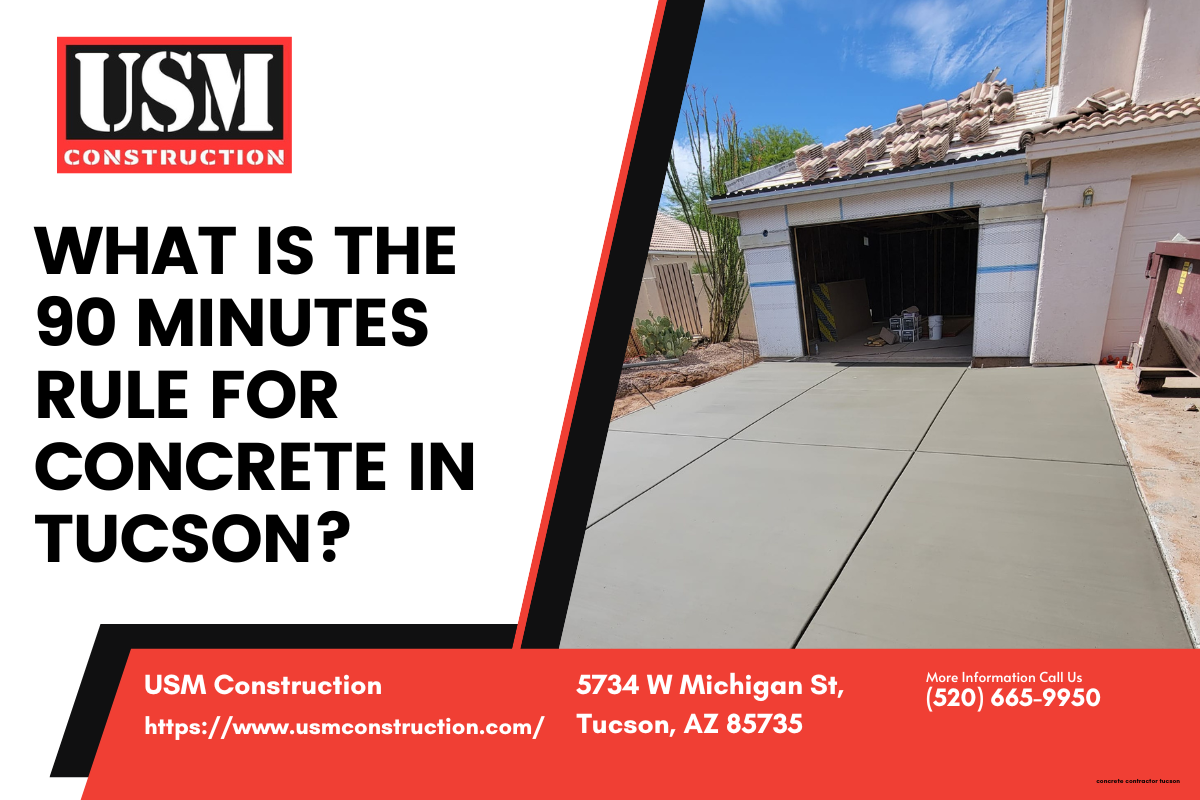TABLE OF CONTENTS
The 4-2-1 rule for concrete is a basic recipe: 4 parts gravel, 2 parts sand, and 1 part cement. While this simple concrete mix serves as a functional starting point for general projects, it's an oversimplification for Tucson. Achieving a durable, crack-free slab that lasts for decades in Southern Arizona requires specific adjustments to the mix to counteract the damaging effects of our extreme heat, destructive monsoon cycles, and unique alkaline soil.
The 4-2-1 Rule: A Universal Starting Point, Not a Tucson Mandate
If you've spent any time researching DIY concrete projects, you've likely come across the "4-2-1 rule." It’s a popular manual concrete mixing guide because of its simplicity. For us in the industry, this is what’s known as a nominal mix, a recipe based on volume that provides a predictable, albeit basic, result.
What Does 4-2-1 Concrete Mean?
The 4-2-1 concrete mix ratio refers to the proportions of its components measured by volume, not weight. Understanding these concrete parts and proportions is the first step:
- 4 Parts Gravel (Coarse Aggregate): This is the primary structural component. The gravel, or aggregate, provides the bulk and strength to the concrete. The optimal gravel size for a 4-2-1 mix is typically 3/4 inch.
- 2 Parts Sand (Fine Aggregate): Sand fills the voids between the gravel, reducing the amount of cement paste needed and improving the workability of the 4-2-1 concrete mix.
- 1 Part Cement: This is the binder. When mixed with water, Portland cement undergoes a chemical reaction called hydration, which glues the sand and gravel together into a rock-solid mass.
This ratio of 4 parts gravel, 2 parts sand, 1 part cement is essentially the same as the 1:2:4 ratio referenced in engineering, which is considered a standard nominal or baseline concrete mix. This is why you see it recommended so often for simple concrete mix for home projects like setting fence posts or creating small footings for a shed. The 4-2-1 concrete for post holes or small Sonotube footings can be adequate. However, its estimated 4-2-1 concrete mix strength in PSI (around 2,500-3,000 PSI) may not be sufficient for more demanding applications like a driveway or a residential foundation, especially in Tucson.
Tucson's Climate: The Unseen Enemy of Your Concrete Foundation
Pouring a new slab in Tucson isn't just a matter of mixing materials; it's a battle against the environment. A standard 4-2-1 mix, used without modification, is unprepared for the challenges our Sonoran Desert climate presents. At USM Construction, with over two decades of experience pouring concrete across Pima County, from Marana to Vail, we've seen firsthand what happens when a mix isn't designed for our region.
The Sonoran Sun: Intense Heat and Evaporation
The relentless Tucson sun is the number one enemy of fresh concrete. The problem is rapid water evaporation. High temperatures accelerate the hydration of cement, a process that can lead to reduced ultimate strength and increased potential for thermal cracking. When water leaves the mix too quickly, the concrete doesn't have time to cure properly, leading to a weaker final product riddled with shrinkage cracks.
This isn't just an anecdotal observation; it's a regulated issue. The Arizona Department of Transportation specifies that the maximum allowable concrete temperature at the time of placement is 95°F, highlighting the critical need to manage heat during installation. This is why experienced concrete contractors in Tucson AZ take extensive measures for hot-weather concreting, something a simple 4-2-1 concrete recipe doesn't account for.
The Monsoon Cycle: From Bone-Dry to Deluge
Anyone who has lived through a Tucson summer knows the monsoon season. It’s a period of dramatic environmental shifts, characterized by high winds, dust storms, and flash floods that create cycles of intense moisture exposure for concrete structures. This cycle is particularly hard on our soil. The ground goes from baked and cracked to super-saturated, causing it to swell and shift. A standard, brittle slab poured with a generic mix lacks the flexibility and strength to withstand this movement, leading to heaving and significant cracking over time. A proper concrete foundation best practice in Tucson involves a mix designed for this reality.
Alkaline Soil: A Chemical Attack from Below
The ground beneath our feet poses another threat. Soils throughout Southern Arizona are characteristically alkaline, with a pH often between 7 and 8.3. This high alkalinity can lead to a destructive process called sulfate attack.
When sulfates from the soil and groundwater penetrate porous concrete, they react with compounds in the cement paste, causing it to expand, crack, and lose its structural integrity. This type of sulfate attack is a significant risk when external sources like our alkaline soil are present. A generic 4-2-1 mix doesn't specify the use of sulfate-resistant cement or a low-permeability design, leaving your foundation vulnerable to long-term chemical degradation.
Beyond the Basic Ratio: The Professional's Mix for Tucson Durability
So, if the 4-2-1 rule is just a baseline, how do we ensure concrete strength in hot weather and create a slab that lasts? The answer lies in moving beyond simple volumetric recipes and focusing on the science of the mix. This is where a professional's expertise becomes invaluable.
The Water-to-Cement Ratio: The True Secret to Concrete Strength
The single most important factor for concrete durability is the water-to-cement ratio (w/c ratio). Many people who are hand mixing concrete for beginners in Tucson make the mistake of adding more water to make the mix easier to work with. While this improves the workability of a 4-2-1 concrete mix, it's a critical error. Excess water creates a porous, weak concrete slab that is susceptible to cracking and sulfate attack.
The goal is to use the absolute minimum amount of water required for the cement to fully hydrate. A lower w/c ratio (typically between 0.40 and 0.50 for quality work) results in stronger, denser, and far more durable concrete. This is the core principle behind developing custom concrete mix ratios in Tucson that can withstand our environment.
Strategic Admixtures: Our Toolkit for a Hostile Environment
To achieve a low w/c ratio without making the concrete impossible to place and finish, professionals use chemical admixtures. These are the "secret ingredients" that allow us to tailor a concrete mix for the specific challenges of a Tucson job site:
- Water-Reducers (Plasticizers): These admixtures allow us to create a workable, flowing concrete mix with significantly less water, directly improving the w/c ratio and final strength.
- Retardants: Essential for summer pours, retardants slow down the chemical reaction of hydration. This counteracts the effects of extreme heat, extending the "90-minute rule" for concrete placement and giving our crews the time needed to properly finish the slab before it sets too quickly.
- Sulfate-Resistant Cement (Type II or V): When building a foundation in Tucson with the 4-2-1 rule as a base, we often need to substitute standard Portland cement with a type designed to resist the chemical breakdown from our alkaline soil.
Comparing Concrete Mixes: Standard 4-2-1 vs. a Tucson-Specific Approach
Understanding the difference between a generic online recipe and a professionally designed mix is crucial for any property owner in Tucson. Here’s a breakdown of how they compare:
Answering Your Common Concrete Questions
Navigating the world of concrete can bring up many questions. Here are a few we often hear:
What is the 20/30/40 rule in concrete?
This is another guideline for mix proportions, focusing on the composition of the total aggregate. It suggests that the aggregate should be roughly 20% fine sand, 30% coarse sand, and 40% gravel. It's a more nuanced approach to aggregate blending than the simple "sand and gravel" of the 4-2-1 rule and aims to create a denser, stronger final product.
How long does concrete need to stay above 40 degrees?
This question pertains to cold-weather concreting. Concrete needs to stay above 40°F (and ideally above 50°F) for at least the first 48 hours to ensure proper hydration and strength gain. Below this temperature, the chemical reaction slows dramatically. While rarely a concern for a new slab in Tucson during the day, overnight winter temperatures can dip, requiring contractors to use insulating blankets to protect fresh pours.
Making the Right Choice for Your Needs
The right concrete mix isn't a one-size-fits-all solution. The best approach depends entirely on your project's scale, purpose, and the long-term performance you expect. As this USM Construction concrete guide has explained, what works for a small garden path is dangerously inadequate for a home's foundation.
For the DIY Homeowner (Shed Pad, Small Walkway)
If you're planning a small, non-critical project, the 4-2-1 rule can be a viable starting point. However, you must take steps to combat our climate. Always mix with cool water, work in the cooler morning hours, and keep the slab damp for several days (wet curing) to slow evaporation. Understand that this mix carries a higher risk of surface cracks, but for a simple shed pad, that may be an acceptable trade-off.
For the Residential Property Owner (Driveway, Foundation, Pool Deck)
When hiring a contractor for a significant investment like a new driveway or patio, you need to vet their expertise. Ask them directly about their approach to hot-weather concreting. They should be able to speak confidently about the water-to-cement ratio, the use of admixtures like retardants, and their curing process. If their answer is simply "we use a standard mix," it's a major red flag. Your investment deserves a custom concrete mix ratio designed for Tucson's specific challenges.
For the Commercial Developer
For large-scale projects, performance is non-negotiable. The focus must be on meeting or exceeding engineering specifications and Pima County concrete foundation codes. The mix must be designed by a professional, tested for compressive strength, and utilize the correct cement type and admixtures to guarantee long-term structural integrity and minimize future maintenance liabilities. The 4-2-1 rule has no place in this level of construction.
Ultimately, the strength and longevity of your concrete are determined by the expertise that goes into designing, mixing, and placing it. The 4-2-1 rule is a piece of general knowledge, but lasting quality in Tucson demands a specific, localized science. For a personalized assessment of your project and a concrete foundation built to withstand the Sonoran Desert, trust the team that understands our climate. Contact USM Construction LLC today for a free, comprehensive quote.


























